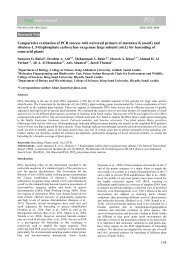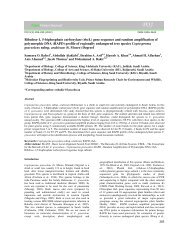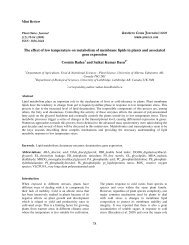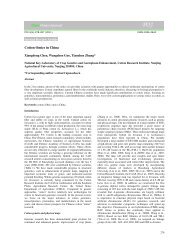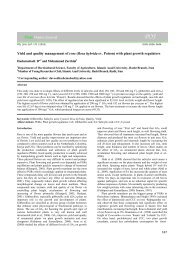Potential of Molecular Markers in Plant Biotechnology - ResearchGate
Potential of Molecular Markers in Plant Biotechnology - ResearchGate
Potential of Molecular Markers in Plant Biotechnology - ResearchGate
You also want an ePaper? Increase the reach of your titles
YUMPU automatically turns print PDFs into web optimized ePapers that Google loves.
Review article<br />
Sequence Characterized Amplified Region<br />
(SCAR)<br />
Introduction: Michelmore et al. and Mart<strong>in</strong> et al.<br />
(1991) <strong>in</strong>troduced this technique where<strong>in</strong> the RAPD<br />
marker term<strong>in</strong>i are sequenced and longer primers are<br />
designed (22–24 nucleotide bases long) for specific<br />
amplification <strong>of</strong> a particular locus. SCARs are DNA<br />
fragments amplified by the PCR us<strong>in</strong>g specific 15–30<br />
bp primers, designed from nucleotide sequences<br />
established from cloned RAPD fragments l<strong>in</strong>ked to a<br />
trait <strong>of</strong> <strong>in</strong>terest. By us<strong>in</strong>g longer PCR primers,<br />
SCARs do not face the problem <strong>of</strong> low<br />
reproducibility generally encountered with RAPDs.<br />
Obta<strong>in</strong><strong>in</strong>g a codom<strong>in</strong>ant marker may be an additional<br />
advantage <strong>of</strong> convert<strong>in</strong>g RAPDs <strong>in</strong>to SCARs,<br />
although SCARs may exhibit dom<strong>in</strong>ance when one or<br />
both primers partially overlap the site <strong>of</strong> sequence<br />
variation. Length polymorphisms are detected by gel<br />
electrophoresis.<br />
Advantages: The ma<strong>in</strong> advantage <strong>of</strong> SCARs is that<br />
they are quick and easy to use. In addition, SCARs<br />
have a high reproducibility and are locus-specific.<br />
Due to the use <strong>of</strong> PCR, only low quantities <strong>of</strong><br />
template DNA are required (10–100 ng per reaction).<br />
Disadvantages: Disadvantages <strong>in</strong>clude the need for<br />
sequence data to design the PCR primers.<br />
Applications: SCARs are locus specific and have<br />
been applied <strong>in</strong> gene mapp<strong>in</strong>g studies and marker<br />
assisted selection (Paran & Michelmore 1993).<br />
S<strong>in</strong>gle Nucleotide Polymorphism (SNP)<br />
Introduction: A noval class <strong>of</strong> DNA markers namely<br />
s<strong>in</strong>gle nucleotide polymorphism <strong>in</strong> genome (SNPs)<br />
has recently become highly pr<strong>of</strong>fered <strong>in</strong> genomic<br />
studies. The fact that <strong>in</strong> many organisms most<br />
polymorphisms result from changes <strong>in</strong> a s<strong>in</strong>gle<br />
nucleotide position (po<strong>in</strong>t mutations), has led to the<br />
development <strong>of</strong> techniques to study s<strong>in</strong>gle nucleotide<br />
polymorphisms (SNPs). Analytical procedures<br />
require sequence <strong>in</strong>formation for the design <strong>of</strong> allelespecific<br />
PCR primers or oligonucleotide probes.<br />
SNPs and flank<strong>in</strong>g sequences can be found by library<br />
construction and sequenc<strong>in</strong>g or through the screen<strong>in</strong>g<br />
<strong>of</strong> readily available sequence databases. Once the<br />
location <strong>of</strong> SNPs is identified and appropriate primers<br />
designed, one <strong>of</strong> the advantages they <strong>of</strong>fer is the<br />
possibility <strong>of</strong> high throughput automation. To achieve<br />
high sample throughput, multiplex PCR and<br />
hybridization to oligonucleotide microarrays or<br />
analysis on automated sequencers are <strong>of</strong>ten used to<br />
<strong>in</strong>terrogate the presence <strong>of</strong> SNPs. SNP analysis may<br />
be useful for cultivar discrim<strong>in</strong>ation <strong>in</strong> crops where it<br />
is difficult to f<strong>in</strong>d polymorphisms, such as <strong>in</strong> the<br />
cultivated tomato. SNPs may also be used to saturate<br />
l<strong>in</strong>kage maps <strong>in</strong> order to locate relevant traits <strong>in</strong> the<br />
genome. For <strong>in</strong>stance, <strong>in</strong> Arabidopsis thaliana a<br />
highdensity l<strong>in</strong>kage map for easy to score DNAmarkers<br />
was lack<strong>in</strong>g until SNPs became available<br />
(Cho et al. 1999). To date, SNP markers are not yet<br />
rout<strong>in</strong>ely applied <strong>in</strong> genebanks, <strong>in</strong> particular because<br />
<strong>of</strong> the high costs <strong>in</strong>volved. Retrotransposon-based<br />
markers Retrotransposons consist <strong>of</strong> long term<strong>in</strong>al<br />
repeats (LTR) with a highly conserved term<strong>in</strong>us,<br />
which is exploited for primer design <strong>in</strong> the<br />
development <strong>of</strong> retrotransposon-based markers.<br />
Retrotransposons have been found to comprise the<br />
most common class <strong>of</strong> transposable elements <strong>in</strong><br />
eukaryotes, and to occur <strong>in</strong> high copy number <strong>in</strong> plant<br />
genomes. Several <strong>of</strong> these elements have been<br />
sequenced and were found to display a high degree <strong>of</strong><br />
heterogeneity and <strong>in</strong>sertional polymorphism, both<br />
with<strong>in</strong> and between species. Because retrotransposon<br />
<strong>in</strong>sertions are irreversible (M<strong>in</strong>ghetti & Dugaiczyk<br />
1993, Shimamura et al. 1997), they are considered<br />
particularly useful <strong>in</strong> phylogenetic studies. In<br />
addition, their widespread occurrence throughout the<br />
genome can be exploited <strong>in</strong> gene mapp<strong>in</strong>g studies,<br />
and they are frequently observed <strong>in</strong> regions adjacent<br />
to known plant genes. Several variations <strong>of</strong><br />
retrotransposon-based markers exist. Sequence-<br />
Specific Amplified Polymorphism (S-SAP) is a<br />
dom<strong>in</strong>ant, multiplex marker system for the detection<br />
<strong>of</strong> variation <strong>in</strong> DNA flank<strong>in</strong>g the retrotransposon<br />
<strong>in</strong>sertion site. Retrotransposon conta<strong>in</strong><strong>in</strong>g fragments<br />
are amplified by PCR, us<strong>in</strong>g one primer designed<br />
from the conserved term<strong>in</strong>us <strong>of</strong> the LTR and one<br />
based on the presence <strong>of</strong> a nearby restriction<br />
endonucleases site. Experimental procedures<br />
resemble those used for AFLP analysis and they are<br />
usually dom<strong>in</strong>ant markers. Compared to AFLP, S-<br />
SAP generally yields fewer fragments but higher<br />
levels <strong>of</strong> polymorphism (Waugh et al. 1997). Interretrotransposon<br />
Amplified Polymorphism (IRAP) and<br />
Retrotransposon- Microsatellite Amplified Polymorphism<br />
(REMAP) are dom<strong>in</strong>ant, multiplex marker<br />
systems that exam<strong>in</strong>e variation <strong>in</strong> retrotransposon<br />
<strong>in</strong>sertion sites. With IRAP, fragments between two<br />
retrotransposons are isolated by PCR, us<strong>in</strong>g outward-<br />
153



